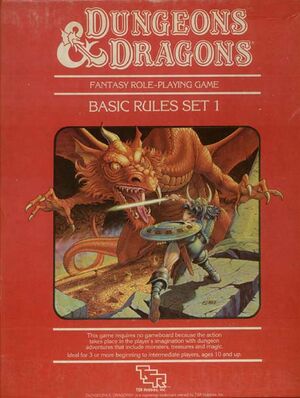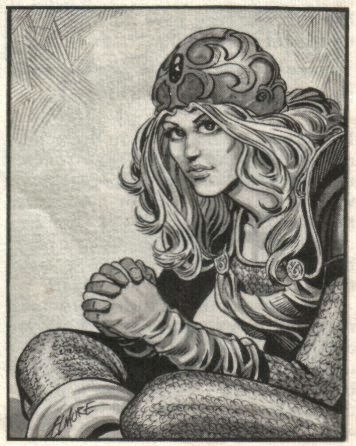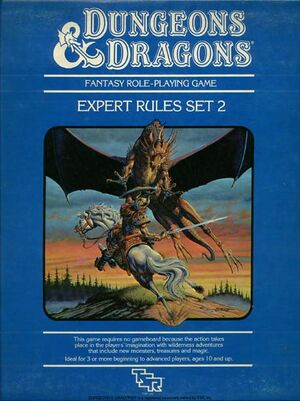Basic Dungeons & Dragons
| This article or section is about something oldschool - and awesome. Make sure your rose-tinted glasses are on nice and tight, and prepare for a lovely walk down nostalgia lane. |
While Gygax was busy making "Advanced" Dungeons & Dragons, a doctor named John Eric Holmes worked on the original rules (plus Supplement I). Holmes intended a single volume to introduce these rules for beginners, and to disassociate himself from that other John Holmes of the 1970s. Holmes' Basic D&D (1977) was to be followed (i.e., split out, and abrogated) in 1981 by Basic and Expert D&D, edited by Tom Moldvay. Between 1983 and 1985, Frank Mentzer redid Moldvay's Sets to scale up to the BECMI series.
While often derided as "kiddie D&D", sales of the basic version exceeded those of the Advanced version for a few years. The system was a stepped system, meaning you could just buy the Basic book at a relatively low cost (around $7) and if you wanted to advance your character past level 3, you could buy the Expert books and so on. Each book in each set was available separately.
Frank Mentzer BECMI[edit]
A few themes in Moldvay / Mentzer as against the (Holmes-compatible) Monster Manual and ensuing AD&D are evident.
M/M against Holmes agreed "henchmen" were creepy and unworkable; they did find a role for paid retainers and, at higher levels, specialists-for-hire.
For all three, your alignment choices were Lawful, Neutral, or Chaotic. The authorial trio assumed that religion shouldn't depend on what specific gods are worshipped - beyond the obvious, that "Chaotic" gods will have wicked clerics. Holmes and Moldvay perhaps did this for simplicity's sake but Mentzer argued the point (a stark break from Gygax, who had insisted (in Deities & Demigods) that weak gods will have weak clerics). For Gygax, that was a role-playing opportunity for an ambitious cleric of a weaker god to raise that god's profile.
Mentzer was more flexible than his predecessors generally, allowing even Demihumans to progress in power past their level caps. He also may have come around to Gygax's opinion on divinities as the Master Set developed into the Immortals, whose whole point is that Immortals start out as weak gods and might progress like mortals do.
On the other side of The DM Screen, none of these guys liked Gotcha Monsters. There's no Roper in the Sets; and when Zeb Cook will moot the Dusanu and the Geonid, Mentzer will give the HELL NO to any of that. All this, despite that they let in that probably-originally-a-typo Thoul.
Holmes didn't Demon - at all. Moldvay figured them as a case-by-case sideshow, chaining one in X2: Castle Amber; which Mentzer overruled as Mature content. Mentzer wouldn't allow these abominations into any succeeding sets until (the 14-year-old-minimum) Immortals. Mentzer will reserve this niche for ever-more-powerful undead like the Nightshade.
Other authors would continue to resist the monster design decisions. Thus how we got the dusanu, the geonid, and even the roper in various modules. And Alphaks manifests as a Balrog in M1: Into The Maelstrom.
Once Mentzer got into the higher-levels, he couldn't avoid the AD&D Planes, as they were getting fleshed out in (say) Q1: Queen of the Demonweb Pits. He went halfsies: yes Elemental Planes, no Great Wheel. Instead he went Michael Moorcock, with a multiverse, under influence from five philosophic "Spheres": Entropy (or Death), Thought, Time, Energy (often fire-themed), Matter. Usually Entropy is the baddie here but some evil Immortals, like Zugzul, might be aligned with others - Energy in his case. Planescape will kick against the Great Wheel too but not as strongly, which its authors regretted, so: Beyond Countless Doorways.
The Boxes[edit]
Basic Set[edit]

This had everything you needed for characters level 1-3. It included a rulebook and - for Moldvay - an adventure: Keep on the Borderlands. Mentzer dumped the module and split the rulebook into a Players book and a DMs book, in parallel with AD&D. He also deliberately wrote to a (reasonably-intelligent) ten-year-old's level, structuring the Player book especially as a tutorial.
Moldvay, like Holmes, had an unfinished adventure of his own: the Haunted Keep. Top floor detailed; lower floors... narrated, in part, and then sketched in side-view.
Mentzer proposed instead an unfinished epic - a revenge story. The initial tutorial is conducted and mostly-narrated by NPC cleric waifu Aleena, hunting a magic-using bandit Bargle. Aleena goes LEEEROY on Bargle and gets needlessly killed; you then track Bargle in the solo Endless Quest-style tutorial through his dungeon. This was beneficial if you lacked players, and also inspired adventure gamebooks and invisible ink adventures like M1: Blizzard Pass.

The DM book proposes a three-tier dungeon in stages: level one is fully described, level two has a dungeon-map mostly without monsters, level three is totally up to the DM to map and populate with only a few pointers. This wiki author considers Mentzer to have done better at mentoring ten-year-old DMs than Moldvay did, since this author was able to script out Mentzer's dungeon and never could figure out how to do the same for Moldvay. Your mileage may vary.
Some printings had 3 hole punch in the books to allow people to keep them in a binder easily. It also included a set of inexpensive dice that you colored in with a crayon. The books only printed material relevant for characters from levels 1-3 and so were much smaller than the average RPG book. This allowed them to be sold cheaply.
Character classes - and races - were Fighter, Cleric, Magic-user, Thief, Dwarf (fighter with infra-vision and badass saving throws), Elf (fighter/magic-user) or Halfling (proto-Ranger). Mentzer and his padawans will bend this.
Expert Set[edit]

This allowed characters to advance from level 4 to level 14.
It came with another module (Moldvay's X1: The Isle of Dread) and another set of dice. This time, Mentzer kept (an updated version of) the module. Both versions center on Karameikos, excerpted from Moldvay's Known World.
It added a few more rules and more material relevant to characters of mid level. Well, Moldvay did. Mentzer suppressed half the spells which Moldvay allowed for fifth and sixth level - perhaps anticipating Arcana Unearthed. Also added combat rules for charging, using mount lances, or setting a spear to receive a charge. Introduced monsters with multiple attacks that could drain 2 levels per attack, instant kill poisons, and numerous other things that made us hate our DM.
As with Holmes, and with Moldvay-Basic, M&M both tried their hand at adventure ideas. Moldvay offered a gnome dungeon, like in S4: Lost Caverns of Tsojcanth, but lame. Mentzer kept Moldvay's map but just went with adventure hooks - mostly interesting, although there's a truly painful dad joke in "the museum of the Smith's son, Ian".
As for Mentzer, he couldn't quit a good villain so Bargle is here again, as "The Infamous" - working for Moldvay's Black Eagle Baron. We'll be seeing both bastards once more in X10: Red Arrow, Black Shield.
Moldvay, based Xenos-despiser, wouldn't let demihumans (Elf, Dwarf, and Halfling) advance in level past this set, although by the end of their respective paths they had impressive saves and fair hit points. Mentzer post-Expert will relent and allow their fighting ability to improve - which leads into . . .
Companion Set[edit]


Mentzer only. Levels 15-25 were covered here. Has its own page now.
If you bought the box set you got yet another set of dice as well (say some people, but I never got any).
Higher level magic (and restored 5th-6th level magic, for Mentzer), more monsters and such (e.g., Beholder and Ghost). Rules for kitting out your Lawful Fighter as a Paladin, your Chaotic Fighter into a sort of anti-paladin named an Avenger, your Neutral Cleric into a Druid, etc. Demihumans get to progress in fighting ability but not along the same numerical level track, because reasons. The DM book included two mini "adventures" which are both just gladiatorial combats; Mentzer had done much better in his Expert revision. If you wanted to stay in Karameikos you had to wait for the Known World Gazetteers.
Speaking of the Known World, the continent Brun is sketched in the Players book, boxed for the X line of modules extant so far plus CM1. Looks familiar...
New rules: running your own settlements (and what happens when you Louis XVI at it); and the War Machine, for waaugh against your enemies (or rebels, if you're Louis XVI).
Master Set[edit]
Levels 26-36.
Since AD&D over there ended at level twenty (technically) this territory is wholly uncharted - what later editions will consider Epic Levels.
This set had the largest and nastiest monsters, the most powerful spells. The players' book added about 20 overpowered polearms with pictures of every one, so you had no excuse for not knowing what a Lochaber Axe is. The "Roll to Hit" tables were extended out to show what was needed to hit AC -20 (of all things), and some of them had printing errors. Hope you packed your magical bonuses! There were rules for making a Thief into an Assassin, which you could then never play, for it was Evil (tm). Although some people can't find those rules in their copy, only finding "Headsmen" and "Thug" monster-type NPCs for the DM to use. There were epic quests to become the greatest of your class, including one called "the Polymath", where your Magic-User had to advance to level 36 in each of the other classes to become a 36/36/36/36 everything. These quests were designed to lead you into Immortality (more on that in a moment).
DM section: artifacts n' relix, taken from our real world, like the Armet of Wayland. The War Machine is expanded with details on how to handle sieges. The monsters bring in the lich at last; and introduce the awesome Nightshades.
As with Companion, there's a map in the cover's inside, except bigger. We get all the continents. "Southold" was probably intended as another Alphatian colony but it's about to get MERLED in X9: Savage Coast. "Thonia" is to get its retcon in the DA quartet.
Box set came with yet another set of the cheap, easily destroyed Crayola Dice (one hears in the legends at least).
Immortals Set[edit]

For when levels mean precisely dick. Instead you get 36 levels of Immortality meaning that you either had either 72 or 180 levels (depending on the path of immortality quest you took to get here) by the end of things. Yeah, there's a reason so few people (if any) ever made use of this set.
This has rules for gods. It has to, who else is going to stand up to you? Well, technically they aren't gods but former mortals who ascended to god-like status and... Listen, it was weird at the time and still kind of is, so just roll with it, okay?
Another set of dice in this box, along with write ups on classical gods of mythology.
The Adventures[edit]
Frontloaded. The B series got at least 12 of these in the end (including one that semi-compiled the first 9 into one adventure). The X series of adventures had up to 13. By contrast CM went only to 9, and M got 5 (most of those were awful). Immortals had 3 modules (did anyone even play those?).
There was another M line, for single-player us in the Basic tier called MSOL (Mystara Solo). Also an O line for one-on-one between the DM and player set for expert level play. The DA series for Blackmoor, also expert level play, and was four modules.
Usually the rule was, "if you're going to include Companion Set shit in your Expert module, list out the vital-statistics in an appendix." It was usually followed, including in the supposedly-expert DA series. Dobson's X10 warfest broke that rule, but hard.
Basically most players didn't get their characters far past level 8, before just switching to AD&D, and TSR catered to that reality. That said, a lot of modules people remember most fondly of 80s D&D were meant for this line, many of them have been mentioned on this page already.
The Rules Cyclopedia by Allston, Schend, Pickens and Watry[edit]

Rules Cyclopedia[edit]
In 1991, TSR was looking to wind down the Basic line in favor of the newest edition of Advanced Dungeons & Dragons but recognized the need to end it on a bit of a high note. As such, they took much of the rules from the Mentzer BECMI line and compile them into one book, the Rules Cyclopedia, with additional rules brought in from the various Gazetteers as they saw fit. While the RC focused mostly on the Basic to Master line of rules, it did touch on the Immortals rules but didn't go too deep with them, favoring instead to release an update to the Immortals rules in its own box set called Wrath of the Immortals later on.
The Rules Cyclopedia was out of print for years and for a while would cost you quite a bit of money to buy (some copies were selling up for $300 dollars) so Wizards of the Coast (seeing some people begging for reprints of the older D&D works) put the Rules Cyclopedia up for Print-on-Demand in 2018. The PoD version is a surprisingly good copy of it. The only major changes between the reprint and the original is the cover was slightly tweaked with the image now being somewhat smaller than the original and the new paper being of a different quality which makes the reprint the same page count but slightly thicker. It is sold in a softcover version for around $25 and a hardcover for around $30.
The Worlds To Play In[edit]
Mostly this stuff was designed for The Known World, later expanded to Mystara - or got retcon'd in't. Where action occurs elsewhere there's usually a Known World connexion. Arneson's Blackmoor, D&D before D&D, in the 1980s ended up shoehorned into Mystara's past. Maybe CM6: Where Chaos Reigns (written by Brits) is an exception although autistic fans have been known to treat its world as Mystaran too.
One separate oldschool D&D setting is Pelinore, for those who've heard of it. But the Mystarans want this one too: https://www.thepiazza.org.uk/bb/viewtopic.php?t=54